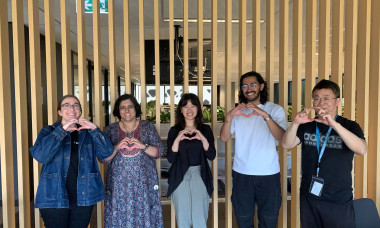How one TAFE changed remote student experiences through innovation
Canberra Institute of Technology’s plastering and tiling program was facing a significant challenge prior to the COVID-19 pandemic. Despite being a part of CIT’s leading construction offering in the ACT, research showed that a lot of tradies who were doing the work were not coming to get the qualification.
“We realised we had to change to meet industry needs in the now,” Construction Team Leader James Folk says.
Enter ReadyTech. As covered in the special webinar Digitising vocational education in a COVID world, CIT engaged the Ready Skills team to ‘throw everything on the table’, in an effort to create a more innovative, integrated and engaging digital student experience across its construction program.
“We wanted to create a system that was so flexible and versatile that it can be used in ways we haven’t thought of yet,” James Folk says. “We needed the solution to be digitally ergonomic and simple, while meeting the needs of students, teachers, the RTO and the employer as well.”
This turned out to be critical during the COVID pandemic, when CIT needed to pivot into online learning. Folk says such flexibility will be needed in future. “With the future looking uncertain we wanted to have the tools to quickly change to meet the needs in community, whether we’re in lockdown or not.”
How CIT’s construction team made it happen
As James Folk himself says, 'innovation is tricky in TAFEs and big organisations." Though there might be widespread recognition of the need for change to meet the future needs of students or industries, it can be hard to achieve successful transformation in ways that deliver all the results that a TAFE is looking for.
But creative magic is possible. Folk says that, after one and a half years of development and six months of being live (at the time of recording), CIT had witnessed Ready Skills technology help change the game for students, trainers, employers and administrators. He says the success for the plastering and tiling program had been ‘brilliant’.
So how did CIT’s construction team manage it – all while pivoting through COVID? Here's three takeaways.
1. Giving space for innovation
The key factor in CIT’s success was the willingness, under the leadership of CEO Leanne Cover, to provide the necessary space for innovation. Allowing experimentation (where it was ‘safe to fail’) allowed the construction team to think differently and create new tools that could benefit the wider TAFE.
Making it safe to fail: James Folk says both he and the construction team were given the necessary ‘space to dream’. “Creativity needs space. There was no pressure to meet milestones and outcomes – if you want to go into a realm that doesn’t exist, you can’t give milestones. With creativity you make mistakes and you learn from that quickly. Give people space to get in there and have a go.”
Picking your champions: TAFEs need to find people who are willing to champion technology. James says he is naturally inquisitive and likes technology, and people like him can be turned into tech champions within a TAFE. If given the time to experiment and surrounding them with others who can augment the project with their skills and insight, James says the results – just like at CIT – can end up being ‘phenomenal’.
Capitalising on momentum: Once the ball is rolling, TAFEs need to be ready to benefit from the ideas that are likely to start coming from everywhere. “After becoming successful, all of a sudden there’s a lot of uptake happening; while there were people who were skeptical about how it would look, as soon as we had something to run with they start to get it, and can’t wait to utilise it. People stepped up when they saw where it was going.”
2. Letting technology do the work
Many of the challenges TAFEs face come from the burden of administration, whether that’s a trainer tracking the tasks a student is doing on a work site, or making sure that learning aligns with compliance requirements. When technology supports or handles this heavy lifting, users can focus on what really matters.
Courses and compliance: The construction team at CIT started from a foundation of building courses students would love to take. It was only with that in mind, and made simple by the Ready Skills’ technology, that they went about mapping courseware back to the competencies required under the qualifications framework, and filling any necessary gaps later. The result was both compliance and student engagement.
A single user platform: Ready Skills provided a single platform or single source of truth for connecting students, trainers, and employers to cut down on administration. Whether students are logging tasks from their mobiles in real time, employers are checking what apprentices were doing with their remote time, or trainers are assessing student competencies via uploaded video, the single platform means everyone is always on the ‘same page’.
The mobile experience: Hearing from CIT, it seems hard to imagine how learning on the job as an apprentice might have been done in the past without a mobile phone. With technology now allowing students to capture evidence as they go or complete assessments, smartphones give all parties involved in the learning journey the ability to capture and process information, avoiding a lot of paperwork that was necessary in the past.
3. Putting the student at the centre
CIT’s construction team always put student learning experiences and outcomes at the centre of their innovation journey. “It’s a really nice way to put courseware together. You start from a creative perspective, creating an enjoyable course, then worry about mapping it to the matrix,” Folk says.
The technology change has allowed students to do more – or all – of their interaction with a course on their smartphones if they want, a medium many students love. It has also enabled the team to increase their focus on the needs of students by reducing the administration burden,” he said.
That shines through in CIT’s innovative use of augmented reality supporting students with learning in remote environments. Enabled through a Kubity integration, it has allowed the study of formwork to drop 3D models ‘onto their bed’ at home they can then see them with their mobile phone.
“I’d like to think the implications of this haven’t been though of yet,” Folk says.
“One of our teachers is good at SketchUp, and has drawn a full house to do the practical stuff with. I dropped it onto the backyard yesterday and walked through the house. I could have recorded it to show students how the load comes on to the lintels, and is dispersed into the footing systems. It makes education fun and interesting.”
“I’m a visual learner. If someone had shown me that as an apprentice, I can see how you could throw away three days of bookwork for half a way of walking through an augmented reality house. Because once the logic clicks, you can do any assessment – once it clicks, you just need to assess the students skills," he says.
Just one advantage is for students with a disability. Because the platform opens the door to self-paced and remote learning, these students can access flexibility unavailable in a regimented classroom environment to gather video evidence or learn via augmented reality in the safety of their loungeroom rather than on a dangerous worksite.
The right tools for the job
TAFEs will inevitably face challenges when transforming student experiences with technology. For example rather than problems with the platform itself, one significant barrier for James and his team at CIT was providing the technical support necessary to get everyone on to the platform with different types of BYO devices.
However, James says the time and effort in taking the journey has been worth it for everyone.
“We talk a lot about being agile and having a platform that's flexible. What we’ve achieved can be used in different ways; in the classroom, at a distance, or on a work site. We think that makes it a good tool. Everyone here is from a vocational background, they are hands on. And we know a good tool that can do many things is worth the money.”
Interested in learning more about how we help TAFE providers with next generation enterprise student management technology? Learn more here.






